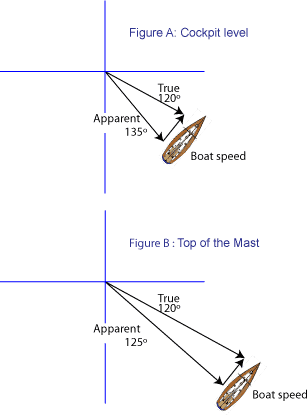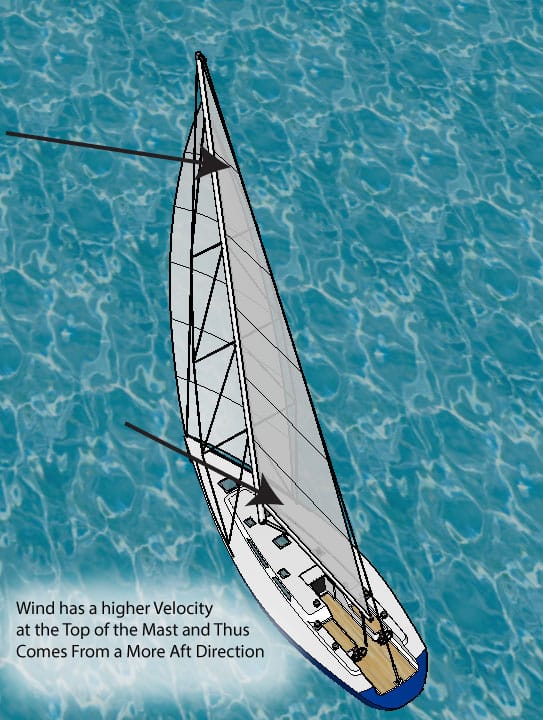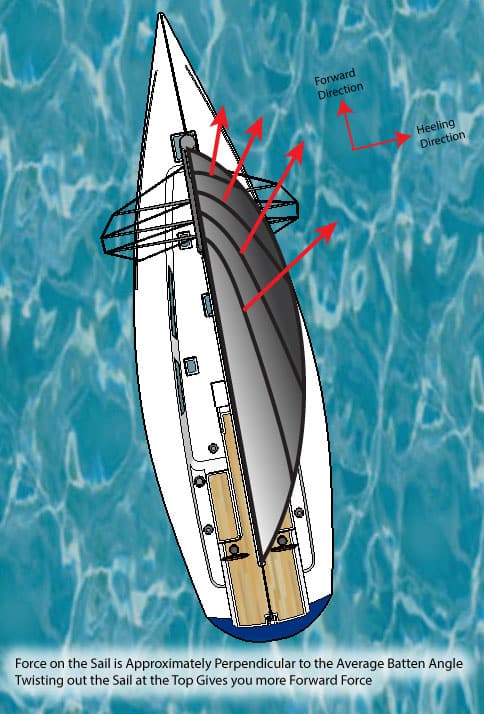3 Reasons to Twist Your Sail Out
NauticEd is the World’s Most Advanced Sailing Education and Sailing Certification Program.
Perfecting Sail Trim and Twist
Here are three reasons you should be twisting out the sail towards the top of the mast
- Get rid of excessive heeling
- Match the wind at the top of the sail to the wind gradient
- Drum Roll … The most important … Change heeling force into forward force.
(1) Getting rid of excessive healing forces.
I’ve written on this topic a few times mostly because it is an important fundamental topic of understanding the forces on a sail.
In a right triangle, a force applied evenly over the surface can be considered to act in one place. This place is called the Center of Pressure and is the geometric center of the right triangle and is 1/3rd of the way up the triangle. It is found by crisscrossing the corners and midpoints.
The propensity to heel is called the Heeling Moment and it is derived from a multiplication of the wind force magnitude and the height of the Center of Pressure.
Thus, the heeling can be reduced by lowering the Center of Pressure. You can do this obviously by reefing but also by twisting out the top of the sail which changes the triangle shape.

Twisted mainsail lowers and moves the center of pressure forward
This also has the added effect of moving the Center of Pressure forward which reduces your weather helm.
(2) Match the wind at the top of the mast to wind gradient
Wind velocity at the surface is less than wind velocity at the top of the mast due to friction of the surface on the wind. This is called Wind Velocity Gradient. In addition there is another effect called Wind Shear which is due to coriolus effect dependent on the distance from the equator and if northern or southern hemisphere. This wind shear creates a different direction of wind at the top of the mast than at the boom height because the wind is seen to twist as it slows down.
When you combine Wind Velocity Gradient and boat velocity you also get different apparent wind directions on the sail. This is best described in detail in our free basic sail trim course.
Because of this effect the wind at the top of the mast is more from an aft direction. Said to be “more aft”.

Wind Velocity is different in speed and direction between surface and top of mast.
When flying a sail then you already know to match the sail angle to the wind to make it most efficient. If the wind direction at the top of the mast is more aft the sail direction must change to be more let out moving up the mast. To achieve this you twist the sail out by allowing the aft of the boom to rise up. This loosens the leach of the sail and allows it to twist out at the top.

Adjust Sail angles up the mast to match apparent wind direction
Control your leach tension via the boomvang. Keep in mind also that your mainsheet will also control leach tension as well. If your mainsheet is in tight, loosening the boomvang will have no effect. When you let out the mainsheet this will deliver the leach control to the boomvang. You can then use the traveler to re-center the boom.
(3) Changing Heeling Force into Forward Force
This is not talked about much but it is the most important when thinking about making your boat go fast.
The force acting on the sail from the wind can be thought of as being approximately in the direction perpendicular to the battens. As the sail is twisted out in going up the mast the force then shifts from sideways unwanted heeling force to desired forward driving force by the nature of its direction.

Twisting the Sail Changes Heeling Force to Forward Force
This then is very important. As you know, not only should you always have your sails let out as much as possible just before luffing to fly the sails efficiently but you should additionally be looking up the sail and adjusting twist as much as possible to translate the resultant force to be forward acting rather that sideways acting. Increase twist until upper sail luffing occurs then tighten slightly.
As with point 2 above use the boomvang, the mainsheet and traveler as your controls.
For more information on Sail Trim, take out Free Basic Sail Trim Course and our advanced Sail Trim Course.
Get started on your Sailing Certification with NauticEd today. We really focus on teaching you all the aspects of sailing. This kind of stuff makes you look like a hero in front of your crew.
- RYA Day Skipper with NauticEd - April 1, 2024
- NauticEd uses the SailTies GPS Tracking App - March 29, 2024
- Sea of Cortez Flotilla – February 2025 - March 8, 2024






